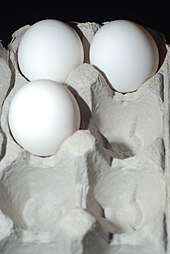Chicken egg sizes
Chicken eggs are graded by size, for the purpose of sales. The egg shell constitutes 8–9% of the weight of the egg (calculated from data in Table 2, F. H. Harms)[1]

United States of America
The United States Department of Agriculture sizing is based by weight per dozen.[2] The most common U.S. size of chicken egg is 'Large' and is the egg size commonly referred to for recipes.
The following egg masses including shell have been calculated on the basis of the USDA sizing:
| Size | Minimum mass per egg | Cooking Yield (Volume)[3] | |
|---|---|---|---|
| Jumbo | 70.9 g | 2.5 oz. | |
| Very Large or Extra-Large (XL) | 63.8 g | 2.25 oz. | 56 ml (4 tbsp) |
| Large (L) | 56.7 g | 2 oz. | 46 ml (3.25 tbsp) |
| Medium (M) | 49.6 g | 1.75 oz. | 43 ml (3 tbsp) |
| Small (S) | 42.5 g | 1.5 oz. | |
| Peewee | 35.4 g | 1.25 oz. | |
Canada
In Canada, modern egg sizes are defined as follows:
| Size | Minimum mass per egg |
|---|---|
| Jumbo | 70 g |
| Extra Large | 63 g |
| Large | 56 g |
| Medium | 49 g |
| Small | 42 g |
| Peewee | Less than 42 g |
Europe
In Europe, modern egg sizes are defined as follows.[5]
| Size | Minimum mass per egg |
|---|---|
| Extra large (XL) | 73 g |
| Large (L) | 63 g |
| Medium (M) | 53 g |
| Small (S) | Less than 53 g |
Post-Soviet countries
In countries which are members of Interstate Council for Standardization, Metrology and Certification: Russia, Belarus, Moldova, Kazakhstan, Azerbaijan, Armenia, Kyrgyzstan, Uzbekistan, Tajikistan, Georgia, and Turkmenistan eggs are sorted into five categories by mass:[6]
| Category | Mass range per egg |
|---|---|
| Highest (В) | 75 g and more |
| Select (О) | 65 g – 74.9 g |
| First (1) | 55 g – 64.9 g |
| Second (2) | 45 g – 54.9 g |
| Third (3) | 35 g – 44.9 g |
Australia
In Australia, the Australian Egg Corporation defines the following sizes in its labeling guide.[7]
| Size | Mass range per egg | Average mass per egg |
|---|---|---|
| King‐size | 71.7 g – 78.5 g | 73 g |
| Jumbo | 66.7 g – 71.6 g | 68 g |
| Extra-Large | 58.3 g – 66.6 g | 60 g |
| Large | 50.0 g – 58.2 g | 52 g |
| Medium | 41.7 g – 49.9 g | 43 g |
In Western Australia, two additional sizes are also standardized by the Golden Eggs Corporation[8]
| Mega or XXXL | 72 g |
|---|---|
| Medium | 43 g |
New Zealand
In New Zealand sizes are based on the minimum mass per egg:[9]
| Size | Minimum mass per egg |
|---|---|
| Jumbo (8) | 68 g |
| Large (7) | 62 g |
| Standard (6) | 53 g |
| Medium (5) | 44 g |
| Pullet (4) | 35 g |
| Size | Mass range per egg |
|---|---|
| Size 0 | Greater than 75 g |
| Size 1 | 70 g – 75 g |
| Size 2 | 65 g – 70 g |
| Size 3 | 60 g – 65 g |
| Size 4 | 55 g – 60 g |
| Size 5 | 50 g – 55 g |
| Size 6 | 45 g – 50 g |
| Size 7 | Less than 45 g |
Brazil
In Brazil sizes are based on the mass. :[10]
| Size | |
|---|---|
| Jumbo | Greater than 66 g |
| Extra | 60 g to 65 g |
| Large | 55 g to 59 g |
| Medium | 50 g to 54 g |
| Small | 45 g to 49 g |
| Industrial | Less than 45 g |
Animal welfare considerations
According to Tom Vasey, chair of the British Free Range Producers' Association, laying larger eggs is painful for the hen. He recommends shoppers only to buy eggs of medium or smaller sizes.[11]
References
- F. H. Harms (June 25, 1990). "Specific Gravity of Eggs and Eggshell Weight from Commercial Layers and Broiler Breeders in Relation to Time of Oviposition". CiteSeerX 10.1.1.827.3676. Cite journal requires
|journal=(help) - "Sizing of Eggs". USDA Food Safety and Inspection Service. Retrieved 2014-05-06.
- "What to Do With Egg Whites". gourmetsleuth.com/. Retrieved 2008-01-13.
- "Egg Regulations C.R.C., c. 284". Justice Laws – Canada. 2013-04-26. Retrieved 2016-11-24.
- UNECE Standard EGG-1 concerning the marketing and commercial quality control of eggs-in-shell (PDF) (Report). United Nations. 2010. p. 9. Retrieved 2015-01-02.
- "ГОСТ 31654-2012 Food chicken eggs. Specifications". protect.gost.ru. Retrieved 2017-06-06.
- "Egg Labelling Guide – Guide to Australian laws, regulations and standards for egg producers" (PDF). Australian Egg Corporation. Retrieved 24 November 2016.
- "Golden Eggs Western Australia Product Range". Goldeneggs.com.au. Archived from the original on 2010-02-08. Retrieved 2010-01-10.
- "Egg Labelling". Egg Producers Federation of New Zealand. Retrieved 2016-11-24.
- "Por que há diferenças no tamanho dos ovos". Ovosite. Retrieved 2017-11-22.
- "Buying large eggs is cruel, shoppers told". The Times. 2009-03-11. Retrieved 2020-04-21.
